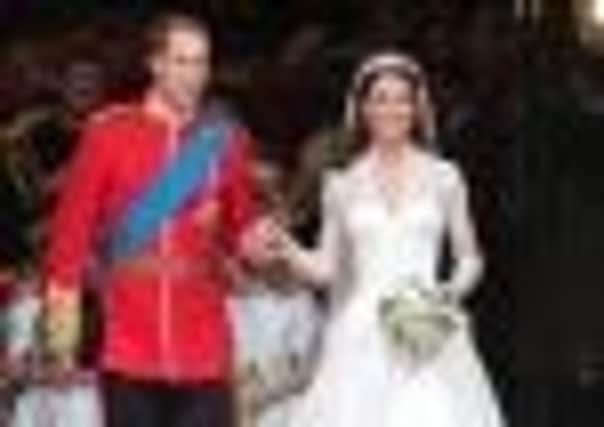Palace lifts the veil on wedding dress of century


Ms Burton, of Alexander McQueen, said Kate wanted to choose a dress with “presence and of historical importance” but with a contemporary feel.
The dress, which was successfully kept a secret until the wedding day, has gone on display in the ballroom of Buckingham Palace as part of an exhibition for the annual summer opening.
Advertisement
Hide AdAdvertisement
Hide Ad“We wanted to look to the past, yet look to the future as well,” Ms Burton said. “There were a lot of references to Victorian corsetry, the padded hip, the tiny cinched-in waist, and also to the arts and crafts movement with all of the hand-work on the lace of the dress and also the bustle inside to create the shape of the back of the dress.


“It has an essence of Victorian but we cut the dress in a very modern way, it is in a very light fabric, also the pleats and the folds create a modern feel rather than a historical piece.
“I think what we wanted to achieve was something that was incredibly beautiful and intricately worked.”
Ms Burton goes into detail about the inspiration behind the dress, the six different types of lace used and the different techniques employed.
Advertisement
Hide AdAdvertisement
Hide Ad“The Duchess wanted to make sure everything was completely thought out,” she added.


She also calls the dress a “real feat of engineering” – the gown featured lace appliqué floral detail and was made of ivory and white satin gazar, with a skirt that resembled “an opening flower” with white satin gazar arches and pleats.
Its train measured nine feet and the lace appliqué for the bodice and skirt was hand-made by members of the Royal School of Needlework, based at Hampton Court Palace. Individual flowers were hand-cut from lace and stitched on to ivory silk-tulle.
The Duchess’s veil, tiara and the diamond earrings she wore also form part of the display.
Advertisement
Hide AdAdvertisement
Hide AdHer veil, made of layers of ivory silk-tulle with a trim of hand-embroidered flowers, was also embroidered by the Royal School of Needlework.


On the big day it was held in place by the Cartier “Halo” tiara, which was her “something borrowed” and was loaned to the bride by the Queen, a tradition for royal weddings.
The tiara was commissioned in 1936 by the Duke of York – later King George VI – for the Duchess of York, later Queen Elizabeth, the Queen Mother, three weeks before he succeeded his brother as king.
Her diamond earrings, which were commissioned by the Middleton family as a personal gift to the bride from her parents, are in the same display cabinet as her shoes and a replica of her bouquet.
Advertisement
Hide AdAdvertisement
Hide AdShane Connolly, artistic director of flowers, said the Duchess had a “huge” input for the flowers and shrubbery used on the day.
“The Duchess and I started talking about the bouquet quite early on in the process.
“We always knew it wouldn’t be very large, that it would include lily of the valley, which is a great favourite of hers and her mother carried in her wedding bouquet.
“We used hyacinths which again the symbolism is constancy of love, so that had a beautiful meaning.
Advertisement
Hide AdAdvertisement
Hide Ad“Myrtle was included, grown from the bouquet of Queen Victoria, and some ivy which symbolises a happy marriage.”
William and Kate’s multi-tiered wedding cake, created by Fiona Cairns, will be shown in the state dining room to complement the wedding dress exhibition.